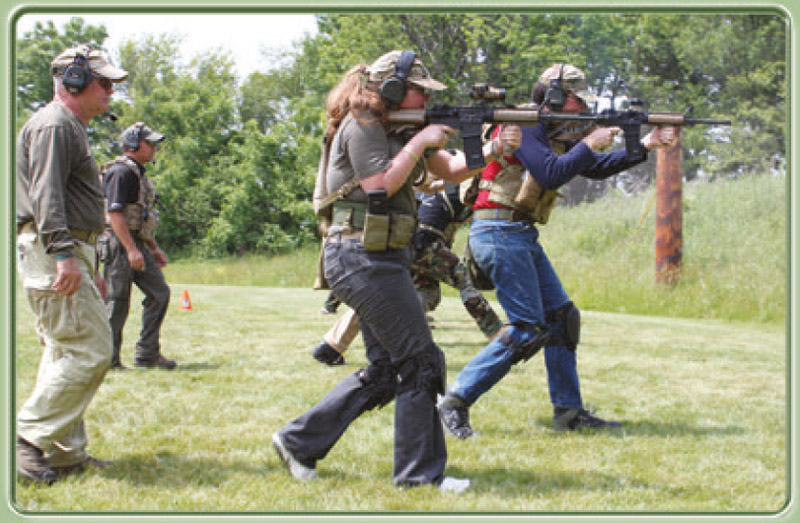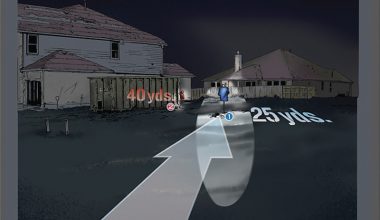
Call me an overachiever. I celebrated National Take Your Daughter to the Range Day by taking four daughters (and three sons) to an EAG Basic Carbine Course. Going to the range isn’t about making noise; it’s about making hits. To get those hits, one needs to shoot under competent instruction.
After a Louis Awerbuck carbine class at the Boone County, Indiana, Sheriff’s Office back in 2002 proved extremely popular, several shooters asked Captain (now Sheriff) Ken Campbell if he would also bring Pat Rogers in as a trainer. Pat came the next year and each year thereafter. So has the Paskey family.
The BCSO range is 115 miles from our front door. Training there is the most cost effective we have found: highest quality trainers, close proximity, and reasonable room rates (Sheriff’s Office rates for anyone who asks).
Why do we do all this? Well, we have carbines in our home—and if there are weapons in the home, everyone should know how to use them.
Table of Contents
HOME SCHOOLING
Good initial training is imperative. Most of my clan received their first formal training at 14 (the age of adulthood at common law). This is the youngest age Pat Rogers will take in an EAG class. Balancing how much training to give a new shooter before class is tough. Too little may render them unsafe; too much may require unlearning and relearning.
In the past, the novice shooters in my family read selections from Pat’s S.W.A.T. articles. But with the release by Panteao Productions of Pat’s Basic Carbine DVD, which covers all the instruction in EAG’s Basic Carbine Class, this process has been greatly simplified.




Properly used, this “entertainment” video is part of what distinguishes Pat as an excellent instructor. Tell students what you are going to tell them in the DVD. Tell them at class. Tell them what you told them after class in the DVD. Positive reinforcement, in Pat’s own words.
Fourteen-year-old Danny began shooting prone, like most of his siblings, using a dedicated .22LR upper, bipod and Aimpoint. Our goal is for the novice shooter to “master” (I really hate it when folks use that word) sights, trigger and follow through. “Sight picture. Press. Sight picture. Ease to reset.” Repeat as necessary.
Two weeks before class, all eight of Clan Paskey’s shooters watched the Basic Carbine DVD several times to focus our minds on the skill sets we would soon be performing in class.
We took off Danny’s training wheels and had him shoot prone using the magazine of an S&W 15-22 as a bipod. We then took him initially to the threeyard line to learn about mechanical offset, fighting stance, and manipulation. As he demonstrated he could perform these skill sets, we moved him farther from the target, introducing him to controlled pairs, hammers, failure drills, and NSRs on both single and multiple targets, just like in the DVD.
The day before we left for class, he shot a full-sized carbine. On TD1 he was ready to learn from Pat in person (and shoot Pat’s EAG/BCM Lightweight Carbine). Same words. Same drills. This formula leads to success.
There is no need, in my experience of preparing seven shooters for initial training, to learn how to use iron sights prior to one’s initial training class. This can and should, in my view, be taught at home after demonstrating capability with the other skill sets taught using a red dot sight.
CLASS WITH THE CLAN
After nine carbine classes with Pat, I felt confident enough to walk on the wild side and shoot an M&P 15-22 MOE for the class. We have three of these at home so we can use our training time more efficiently.
Every Basic Carbine drill except a double-feed malfunction clearance is doable with the sub-caliber carbine. Using the magazine as a monopod works, too. The feed tower doesn’t break on S&W magazines as does that of the Black Dog Machine .22LR magazines that we used in the past on our dedicated uppers.
I fired just over 600 rounds of WalMart’s Federal Bulk Pack and had no malfunctions, lubing the gun morning and noon. As Pat concluded, “It is a viable gun to use at class.” Cheap, too!
Our carbines are assembled from Colt parts: 14.5-inch M4 barrels with permanently attached Vortex flash hiders and KAC RAS or 16-inch LW barrels with KAC FF RAS.
Why not LaRue free-float rails, which are arguably the best? Simple: Wes Grant built these uppers for us back before Mark LaRue was making rails. Some uppers even sit on Colt AR-15 lowers with Colt OEM offset pins. They work. No drama here.
I shot my M4 for the first Type 3 malfunction clearance drill. After shooting the .22LR for the better part of two days, I consciously focused on rolling my shoulder forward and pulling back on the butt to increase my control of the carbine. The recoil of my M4 was harsh compared to that of the 15-22. (Duh!)
Pat loaned me his gun, a mid-length, to finish the malfunction drills. I was amazed that the felt recoil from his midlength was much, much closer to that of the 15-22 than to that of my M4.
As some of our barrels are approaching 15,000 rounds through the bore, it looks like I’m going to sell some Colt barrels and replace them with BCM mid-length barrels.
All hands shot Aimpoints on LaRue mounts. No drama here, either. We replaced M3s with T-1s/H-1s and painted R-1s on our working carbines.
I shot with a 2 MOA M3 on the 15-22 to see if a new prescription gave me a dot rather than a starburst. I had taken an Aimpoint with me to my last eye exam. After the Doc worked her magic, I had her further tweak to correct my rather bad astigmatism, looking at the chart through the Aimpoint to obtain the clearest red dot possible.
It worked! Now even on the previously problematic 2 MOA sight, I get a crisp, clear red dot.
AMMO (LOTS OF IT)
Quality ammunition costs money, lots of money, for the clan to shoot. This year, we loaded over 3,000 rounds for class on a Dillon 550B. All cases were bought as once-fired Lake City, re-sized and trimmed to 1.76 inch. Primers (Rem 71/2 BR) were individually seated with an RCBS hand primer and checked for depth by a second set of eyes/fingertips.
Powder (26.0 grains of W748) was dumped from a Redding BR-30 and checked by a second set of eyes. Powder weight was verified in each 50-round batch. Bullets (.224, 55-grain FMJ that had been dropshipped from Black Hills Shooters Supply) were seated and a taper crimp applied at the cannelure.
Each loaded cartridge was inspected and passed through a Dillon case gage. Each was inspected again and loaded on stripper clips. Still, a dummy round I had loaded (bullet with neither primer nor powder in a Federal case) found its way onto a stripper clip. It wound up in Danny’s magazine. Click. Push/pull. Rack and roll. Back in the fight. Bang! Our QC wasn’t perfect, but we had no issues with those rounds actually loaded.
PROGRAM OF INSTRUCTION
Pat’s POI is constantly evolving. Compared to what we were first taught in 2003, he has since added proven and better TTPs to those that already “work pretty good. ” Examples include: Rolling the strong-side shoulder into the butt of the gun to improve contact with the shoulder. Extending the support- side leg when rolling over from kneeling. Offset drill from three out to 15 yards immediately after zeroing to drive home the need to compensate for mechanical offset and consciously work on follow-through.
Why attend a mere two-day carbine class when three-day classes are available? Time is money. Sometimes we lack both to get all the training we desire. Good training under competent instruction is also imperative to verify the fundamentals are being executed properly. And as Pat noted, sustainment training “prevents the ‘Oops, I have to start all over again’ syndrome of the occasional shooter. ”
One receives the same personal attention in the Basic Class as in the Carbine Operator Course. This is a good thing.
There is little excuse for not training with EAG Tactical, as Pat Rogers offers classes all over the country. A student can even use a .22LR to get the basics.
And as Pat says, “It’s all about the basics—the basics of gunfighting!”





